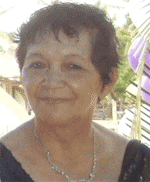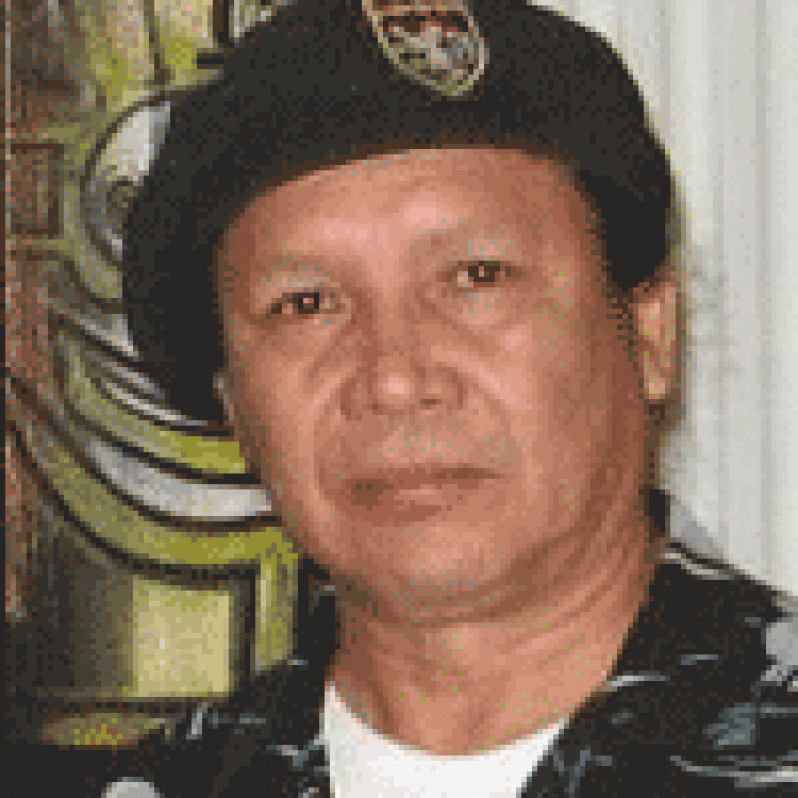GEORGE Simon paints complex but beautiful paintings that bring fresh delight to the viewer when a new dimension is discovered. His work can be seen in prominent places in Guyana, including the Umana Yana, the National Stadium, the Cheddi Jagan International Airport, and the University of Guyana.
 Born to Mark Simon, a wood cutter, and Olive a housewife, in St. Cuthbert’s Mission on April 23, 1947,
Born to Mark Simon, a wood cutter, and Olive a housewife, in St. Cuthbert’s Mission on April 23, 1947,
Simon spent his early childhood living close to the forest, travelling on the river, and experiencing the full range of Nature’s gifts.
The community was self-sufficient, and there was very little use for money; hence there were no shops, the artist disclosed. This easygoing lifestyle is very important to Simon, as the simple things in life still matter to him, even though he has left the community for a less traditional lifestyle.
Simon obtained primary education in his village; but at age 12, he was adopted by an English Anglican priest named James William Pink, who was at the time serving the Mahaica River churches. When the priest was reassigned to serve parishes in the Upper Demerara River, he took Simon with him to the mining town of Linden. When the priest was reassigned to the St George’s Cathedral in the capital, Georgetown, Simon, then a youth, was enrolled at Christ Church Secondary School, where he pursued studies in English, Mathematics, Geography, Hygiene and Physiology.
There were no teachers available at the school to teach art, but young Simon began studying art books on his own, and practising charcoal drawings. His hard work in art was rewarded when he passed that exam.
In 1972, he enrolled at Grey’s Technical College in Thurrock, Essex, England to do the Advanced Level examination in Art, and focused on Painting and Drawing. He later read for a Bachelor of Arts Degree in Fine Art at the University of Portsmouth, and graduated with Honours in 1978. His studies focused on Art History and 19th Century Art.
On his return to Guyana in 1978, Simon was appointed to the Burrowes School of Art as a lecturer. He got close to Founder and Director Dennis Williams, who introduced him to the disciplines of Archaeology and Anthropology, and their revelations of the indigenous cultures of Guyana, which were to so stimulate and enrich his future work.
In 1985, Simon won the Painting Award in the National Exhibition of the Visual Arts, this country’s major fine art exhibition; and in 1998, he received the Golden Arrow of Achievement (A.A.) for exceptional contribution to social and community work among the Amerindian Peoples of Guyana, and for exceptional contribution to the arts and culture.
Simon has described his work as concentrated on drawing attention to the indigenous people, and how they have lived with the environment in mind.
Simon’s earlier works and the techniques he employed — particularly during the 80s, when he reflected his heritage by depicting Amerindians in traditional costumes and activities — were influenced by his travels to Africa, North America and the Caribbean.
He has been an influential supporter of fellow Lokono artists of his native St. Cuthbert’s; and has been involved in numerous exhibitions, workshops and cultural institutions in Guyana, the Caribbean, Canada and Africa, including ‘Moving Circle’ 2002 and ‘Shamanic Signs’, a solo exhibition staged in 2006 at the National Gallery.
Simon became research assistant to Denis Williams at the Walter Roth Museum from that period, and worked with him until 1992. He accompanied Williams, or appeared on his behalf working at sites throughout Guyana.
At sometime around 1988, he set up a workshop in drawing and design in his village of St Cuthbert’s in an effort to guide many of the artists then in early stages of development. From that effort, a group of 10 artists emerged as Guyana’s finest, including premier sculptor Oswald Hussein (one of Guyana’s finest) and sculptors Lynus Clenkien, Ronald and Telford Taylor, and Foster Simon.
Simon travelled to the African Republic of Chad in December 1998, and worked with the Language Centre of the Public Affairs Department of the United States Embassy, serving as Director of the American Language Centre; but his love of art and of mentoring others soon set in.
His keen interest in African art and African artists moved him to mobilise a group of African artists to set up an Art Studio called House of African Art in Chad’s capital city, N’Djamena. The sale of African art helped to raise funds to sustain the studio; and when Simon left Chad, the studio was handed over to the Government of Chad.
He went to Lyons, France in 2001, where he was Artist in Residence at the Arts and Spices Gallery, and exhibited there before later moving back to Canada. In that same year, he moved to northern Haiti and set up Escola Nueva, a school where he taught English, Art and Music. There he also set up a musical band.
Simon is now a member of the Teaching Faculty in the School of Education and the Humanities at the University of Guyana, and has had considerable influence on young artists.
He was one of the speakers at a three-day conference, hosted by the Institute for Colonial and Post-colonial Studies at the University of Leeds in the United Kingdom, which brought together scholars, professionals and arts practitioners to investigate the ways in which sacred traditions have shaped discourses and practices of empowerment, emancipation, change, resistance, and survival in different cultural and historical contexts.
This inclusion attests to the importance of his work and his international acclaim as one of the best known Lokono Arawak artists in Guyana, the Caribbean, and indeed the world.
This year, Simon became the most recent inductee to the Anthony N. Sagba Caribbean Awards for Excellence (ANSCAFE), launched by the ANSA McAL Foundation in October 2005 and now the English-speaking Caribbean’s leading recognition programme in Arts, Science and Technology, and Public and Civic Work. Simon is the fourth Guyanese Sabga Award winner, and his achievement is credited to his outstanding work in archaeology, which follows an important discovery in Guyana that might cause history books about the pre- Columbian past of the Americas and world civilization to be radically rewritten.
(2)
DOROTHY is a proud Wapishana woman at heart, although Arawak blood runs in her veins. One of her driving passions is preserving the Wapishana tongue in Sand Creek, a Wapishana village located 60 miles from Lethem.
Background
Dorothy was born to Ignatius and Altassi Atkinson at Moruca Village, in the North West District, 60 years ago. Her Arawak father worked as a Medical Ranger assigned to visit communities in South and Central Rupununi. Her mother Altassi came from the Brazilian border community of Bom Fim. The two got married and produced 10 offspring, Dorothy being one of them.
The family moved to Sand Creek, in Central Rupununi, while Dorothy was an infant, and she grew up absorbing the Wapishana culture of that community.
She was brought up as a typical Wapishana, engaged in farming, fishing, and hunting; and has retained that lifestyle today, as currently, she and her husband are livestock farmers.
Dorothy attended school with Stephen Faria, grandson of the country’s first Amerindian Parliamentarian, Stephen Campbell. Dorothy and Stephen Faria got married in 1974, and a few years later, she ended her career as a teacher.
After the late President Cheddi Jagan designated September Amerindian Heritage Month in 1995, Dorothy rounded up the youths of Sand Creek and formed the group “Kaitiwau” in 1999 with the intention of showcasing the Wapishana culture. Kaitiwau is the Wapishana name for the village of Sand Creek. Kaitiwau currently comprises 50 youths, but their activities are not confined to song and dance, as Dorothy teaches them sexual and reproductive health, moral education, and cooking.
She devised ways to learn about the Wapishana culture from the elders of the village, and set about choreographing dances and composing songs for Kaitiwau.
For the past decade, Dorothy has been designing costumes for the group, using spun cotton accessorized with materials from the forest. At times, this involves going into the jungle to gather special birds’ feathers, flowers and bamboo. For the male members of the group, tiger skin is used together with “donkey eyes” stones and “buck beads.” The group has performed at numerous functions.
Many who look at Amerindian dances, such as the Mari Mari, see the performers seemingly performing the same movements over and over again. Dorothy tries to maintain the traditional movements, but has added new ones to spice up the choreography and keep the audience interested.



.jpg)








